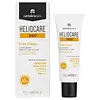What's inside
What's inside
 Key Ingredients
Key Ingredients

 Benefits
Benefits

 Concerns
Concerns

 Ingredients Side-by-side
Ingredients Side-by-side

Water
Skin ConditioningOctocrylene
UV AbsorberEthylhexyl Salicylate
UV AbsorberButyl Methoxydibenzoylmethane
UV AbsorberButylene Glycol
HumectantPhenylbenzimidazole Sulfonic Acid
UV AbsorberArginine
MaskingDimethicone
EmollientDiethylamino Hydroxybenzoyl Hexyl Benzoate
UV FilterPhenethyl Benzoate
EmollientSilica
AbrasiveTris-Biphenyl Triazine
UV AbsorberPolymethylsilsesquioxane
Styrene/Acrylates Copolymer
Polypodium Leucotomos Leaf Extract
Skin ProtectingEthylhexyl Triazone
UV AbsorberPhysalis Angulata Extract
Skin ProtectingPlankton Extract
Skin ConditioningMelanin
Skin ProtectingOxothiazolidine
Skin ProtectingSodium Hyaluronate
HumectantGlycerin
HumectantTrehalose
HumectantUrea
BufferingSerine
MaskingPullulan
Algin
MaskingC20-22 Alkyl Phosphate
EmulsifyingPhenylpropanol
MaskingC20-22 Alcohols
Emulsion StabilisingVp/Acrylates/Lauryl Methacrylate Copolymer
Sodium Acrylates Crosspolymer-2
AbsorbentAcrylates/C10-30 Alkyl Acrylate Crosspolymer
Emulsion StabilisingPropylene Glycol
HumectantCaprylyl Glycol
EmollientPropanediol
SolventPentylene Glycol
Skin ConditioningMethicone
EmollientCaprylic/Capric Triglyceride
MaskingDisodium Phosphate
BufferingGlyceryl Polyacrylate
Disodium EDTA
Tocopheryl Acetate
AntioxidantPotassium Phosphate
BufferingLecithin
EmollientBHT
AntioxidantSodium Benzoate
MaskingTocopherol
AntioxidantPhenoxyethanol
PreservativeParfum
MaskingLinalool
PerfumingLimonene
PerfumingWater, Octocrylene, Ethylhexyl Salicylate, Butyl Methoxydibenzoylmethane, Butylene Glycol, Phenylbenzimidazole Sulfonic Acid, Arginine, Dimethicone, Diethylamino Hydroxybenzoyl Hexyl Benzoate, Phenethyl Benzoate, Silica, Tris-Biphenyl Triazine, Polymethylsilsesquioxane, Styrene/Acrylates Copolymer, Polypodium Leucotomos Leaf Extract, Ethylhexyl Triazone, Physalis Angulata Extract, Plankton Extract, Melanin, Oxothiazolidine, Sodium Hyaluronate, Glycerin, Trehalose, Urea, Serine, Pullulan, Algin, C20-22 Alkyl Phosphate, Phenylpropanol, C20-22 Alcohols, Vp/Acrylates/Lauryl Methacrylate Copolymer, Sodium Acrylates Crosspolymer-2, Acrylates/C10-30 Alkyl Acrylate Crosspolymer, Propylene Glycol, Caprylyl Glycol, Propanediol, Pentylene Glycol, Methicone, Caprylic/Capric Triglyceride, Disodium Phosphate, Glyceryl Polyacrylate, Disodium EDTA, Tocopheryl Acetate, Potassium Phosphate, Lecithin, BHT, Sodium Benzoate, Tocopherol, Phenoxyethanol, Parfum, Linalool, Limonene
Water
Skin ConditioningDiethylamino Hydroxybenzoyl Hexyl Benzoate
UV FilterC12-15 Alkyl Benzoate
AntimicrobialAlcohol Denat.
AntimicrobialGlycerin
HumectantBis-Ethylhexyloxyphenol Methoxyphenyl Triazine
Skin ConditioningButylene Glycol Dicaprylate/Dicaprate
EmollientPhenylbenzimidazole Sulfonic Acid
UV AbsorberDibutyl Adipate
EmollientDistarch Phosphate
AbsorbentEthylhexyl Triazone
UV AbsorberTapioca Starch
Polyglyceryl-6 Stearate
EmollientBehenyl Alcohol
EmollientCetearyl Alcohol
EmollientGlycyrrhetinic Acid
Skin ConditioningGlycyrrhiza Inflata Root Extract
Skin ConditioningCopernicia Cerifera Cera
EmollientPolyglyceryl-6 Behenate
Emulsion StabilisingCarrageenan
Xanthan Gum
EmulsifyingHydroxypropyl Methylcellulose
Emulsion StabilisingSilica
AbrasiveTrisodium Ethylenediamine Disuccinate
Sodium Hydroxide
BufferingHydroxyacetophenone
AntioxidantEthylhexylglycerin
Skin ConditioningBenzyl Alcohol
PerfumingWater, Diethylamino Hydroxybenzoyl Hexyl Benzoate, C12-15 Alkyl Benzoate, Alcohol Denat., Glycerin, Bis-Ethylhexyloxyphenol Methoxyphenyl Triazine, Butylene Glycol Dicaprylate/Dicaprate, Phenylbenzimidazole Sulfonic Acid, Dibutyl Adipate, Distarch Phosphate, Ethylhexyl Triazone, Tapioca Starch, Polyglyceryl-6 Stearate, Behenyl Alcohol, Cetearyl Alcohol, Glycyrrhetinic Acid, Glycyrrhiza Inflata Root Extract, Copernicia Cerifera Cera, Polyglyceryl-6 Behenate, Carrageenan, Xanthan Gum, Hydroxypropyl Methylcellulose, Silica, Trisodium Ethylenediamine Disuccinate, Sodium Hydroxide, Hydroxyacetophenone, Ethylhexylglycerin, Benzyl Alcohol
 Reviews
Reviews

Ingredients Explained
These ingredients are found in both products.
Ingredients higher up in an ingredient list are typically present in a larger amount.
Diethylamino Hydroxybenzoyl Hexyl Benzoate (DHHB) is a chemical UV-A absorber. It is formulated for high UVA protection (320-400 nm).
DHHB is well-liked for:
DHHB has been approved by the EU, Japan, Taiwan, and South America for use up to 10%. Unfortunately, it has not been approved for use in the US or Canada due to slow regulatory processes.
This ingredient is soluble in oils, fats, and lipids.
Learn more about Diethylamino Hydroxybenzoyl Hexyl BenzoateEthylhexyl Triazone is a modern chemical sunscreen that protects from UV-B radiation.
It is the most effective of existing UV-B filters, as it provides the highest level of photo-stable absorption. It protects from the entire UV-B range (280 to 320nm), with it's highest level of protection at 314nm.
Ethylhexyl Triazone is oil soluble, oderless and colorless, which mean it is able to be incorporated into a variety of different formulations.
It is not currently available within the United States due to slow changing FDA regulations. Outside of the US, it is used in formulations at concentrations up to 5%.
Learn more about Ethylhexyl TriazoneGlycerin is already naturally found in your skin. It helps moisturize and protect your skin.
A study from 2016 found glycerin to be more effective as a humectant than AHAs and hyaluronic acid.
As a humectant, it helps the skin stay hydrated by pulling moisture to your skin. The low molecular weight of glycerin allows it to pull moisture into the deeper layers of your skin.
Hydrated skin improves your skin barrier; Your skin barrier helps protect against irritants and bacteria.
Glycerin has also been found to have antimicrobial and antiviral properties. Due to these properties, glycerin is often used in wound and burn treatments.
In cosmetics, glycerin is usually derived from plants such as soybean or palm. However, it can also be sourced from animals, such as tallow or animal fat.
This ingredient is organic, colorless, odorless, and non-toxic.
Glycerin is the name for this ingredient in American English. British English uses Glycerol/Glycerine.
Learn more about GlycerinThis ingredient is more commonly known as Ensulizole, a chemical sunscreen ingredient.
Ensulizole mainly protects UV-B (290-340 nm) but offers a little UV-A (320-400 nm) protection. It is often paired with less photo-stable sunscreen ingredients due to its photo-stability.
Due to it being water-soluble, Ensulizole helps give sunscreens a light and non-oily texture.
Ensulizole is approved worldwide:
Learn more about Phenylbenzimidazole Sulfonic AcidSilica, also known as silicon dioxide, is a naturally occurring mineral. It is used as a fine, spherical, and porous powder in cosmetics.
Though it has exfoliant properties, the function of silica varies depending on the product.
The unique structure of silica enhances the spreadability and adds smoothness, making it a great texture enhancer.
It is also used as an active carrier, emulsifier, and mattifier due to its ability to absorb excess oil.
In some products, tiny microneedles called spicules are made from silica or hydrolyzed sponge. When you rub them in, they lightly polish away dead skin layers and enhance the penetration of active ingredients.
Learn more about SilicaWater. It's the most common cosmetic ingredient of all. You'll usually see it at the top of ingredient lists, meaning that it makes up the largest part of the product.
So why is it so popular? Water most often acts as a solvent - this means that it helps dissolve other ingredients into the formulation.
You'll also recognize water as that liquid we all need to stay alive. If you see this, drink a glass of water. Stay hydrated!
Learn more about Water